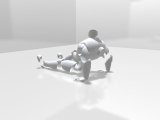White stuff
 There’s one conceptual problem that Paulius told me the other day: imagine that you have a white sheet of paper and a black pencil. How would you draw an object that emits light? It’s puzzling at first, but surely it can be done :)
There’s one conceptual problem that Paulius told me the other day: imagine that you have a white sheet of paper and a black pencil. How would you draw an object that emits light? It’s puzzling at first, but surely it can be done :)
I’m facing with the same problem in our next demo: we have a white character in a white, brightly lit room. Even more, there will be some light emitting “stuff” in there. Now, how to render all this so that it’s not “washed out”, too bright and with no contrast?
I’m not happy with the way it looks right now, but we’re heading there.